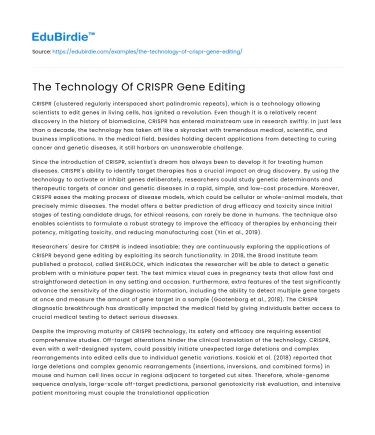CRISPR (clustered regularly interspaced short palindromic repeats), which is a technology allowing scientists to edit genes in living cells, has ignited a revolution. Even though it is a relatively recent discovery in the history of biomedicine, CRISPR has entered mainstream use in research swiftly. In just less than a decade, the technology has taken off like a skyrocket with tremendous medical, scientific, and business implications. In the medical field, besides holding decent applications from detecting to curing cancer and genetic diseases, it still harbors an unanswerable challenge.
Since the introduction of CRISPR, scientist's dream has always been to develop it for treating human diseases. CRISPR's ability to identify target therapies has a crucial impact on drug discovery. By using the technology to activate or inhibit genes deliberately, researchers could study genetic determinants and therapeutic targets of cancer and genetic diseases in a rapid, simple, and low-cost procedure. Moreover, CRISPR eases the making process of disease models, which could be cellular or whole-animal models, that precisely mimic diseases. The model offers a better prediction of drug efficacy and toxicity since initial stages of testing candidate drugs, for ethical reasons, can rarely be done in humans. The technique also enables scientists to formulate a robust strategy to improve the efficacy of therapies by enhancing their potency, mitigating toxicity, and reducing manufacturing cost (Yin et al., 2019).
Save your time!
We can take care of your essay
- Proper editing and formatting
- Free revision, title page, and bibliography
- Flexible prices and money-back guarantee
Researchers' desire for CRISPR is indeed insatiable; they are continuously exploring the applications of CRISPR beyond gene editing by exploiting its search functionality. In 2018, the Broad Institute team published a protocol, called SHERLOCK, which indicates the researcher will be able to detect a genetic problem with a miniature paper test. The test mimics visual cues in pregnancy tests that allow fast and straightforward detection in any setting and occasion. Furthermore, extra features of the test significantly advance the sensitivity of the diagnostic information, including the ability to detect multiple gene targets at once and measure the amount of gene target in a sample (Gootenborg et al., 2018). The CRISPR diagnostic breakthrough has drastically impacted the medical field by giving individuals better access to crucial medical testing to detect serious diseases.
Despite the improving maturity of CRISPR technology, its safety and efficacy are requiring essential comprehensive studies. Off-target alterations hinder the clinical translation of the technology. CRISPR, even with a well-designed system, could possibly initiate unexpected large deletions and complex rearrangements into edited cells due to individual genetic variations. Kosicki et al. (2018) reported that large deletions and complex genomic rearrangements (insertions, inversions, and combined forms) in mouse and human cell lines occur in regions adjacent to targeted cut sites. Therefore, whole-genome sequence analysis, large-scale off-target predictions, personal genotoxicity risk evaluation, and intensive patient monitoring must couple the translational application of CRISPR.
The rapidly developing technology of CRISPR gene-editing is yielding enormously beneficial results in modern medical science. Even though massive efforts have already focused on technology optimization and disease management, new challenges will always emerge along with the new findings of its clinical trial application. Consequently, future studies of CRISPR are required to focus on an in-depth understanding of human intracellular mechanisms for appropriate clinical application.
Bibliography
- Gootenberg JS., Abudayyeh OO., Kellner MJ., Joung J., Collins JJ., Zhang F. Multiplexed and portable nucleic acid detection platform with Cas13, Cas12a, and Csm6. Science. 2018;360(6387):439-444
- Kosicki M., Tomberg K., Bradley A. Repair of double-strand breaks induced by CRISPR-Cas9 leads to large deletions and complex rearrangements. Nat. Biotechnol. 2018;36:765–771
- Yin H., Xue W., Anderson DG. CRISPR–Cas: a tool for cancer research and therapeutics. Nat. Rev. Clin. Onc. 2019;6:281–295






 Stuck on your essay?
Stuck on your essay?

